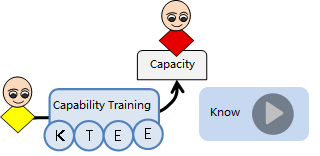|
|
| Successful Case
|
| Continental Automotive Electronics |
| Bosch Automotive Electronics |
| Schaeffler electric drive |
| Joyson Automotive Electronics |
| Huawei Technical Center |
| BMW Automotive Research and Development Center |
| Geely Auto Research Institute |
| Byd Automotive Research Institute |
| |
|
|
|
|
|
|
| Courses > Modeling |
|
 |
|
UML + RoseRealtime + Embedded Systems Analysis Design
|
Views 
|
|
 |
|
|
Mr. Deng
|
| The first batch of evangelists of UML embedded modeling in China have the dual ability of practical experience and theoretical inquiry. |
| |
|
|
| Time Location: Beijing, Shenzhen and Shanghai open classes based on registration |
| Course Cost’╝Ü1000$/Person
|
|
|
|
| Internal Training: You can customize internal training according to the needs of the enterprise. |
|
 |
Certification:
Learn about the competency model before training.
Competency assessment after training:
Online
Exams
Ability Analysis, give learning suggestions
The qualified person shall be issued a certificate as proof of vocational skill qualification
|
 |
|
|
| This course is primarily for developers and covers Rational The use of the Rose RealTime toolset encompasses all aspects of the real-time software development lifecycle: from analysis to design, testing, debugging, configuration management, and deployment. This course covers the "Unified Modeling Language" necessary to model concurrent, distributed, or real-time systems (UML)".
In addition, it was introduced to the trainees Rational Unified ProcessTM, which is an iterative, use-case-driven, and architecture-centric process for software systems development. Participants will also learn about the use of the toolset, which is suitable for: All major workflows defined in Rational Unified Process.
In the analysis and design phase, both in use Users of C, C++, and Java can benefit from this visual modeling technique.
Participants can gain experience using the tools by doing experiments. They consist of three parts: first the demonstration, then the warm-up exercises, and finally the case (practical) exercises. "Demonstration" is when the teacher demonstrates the technique on a simple model, "Warm-up" allows the student to practice on a simple model, and case (practical) exercises allow the student to apply the technique to building the entire system. In addition, students can also use it Rose RealTime's code generation and execution capabilities to run, test, and debug designed models. |
| |
| Training Goal |
By the end of this course, participants should be able to:
1. Apply iterative, use case-driven, and architecture-centric processes to develop robust design models.
2. Understand the problems that may be encountered in real-time system development and the issues that need to be considered, including: responsiveness, timeliness, concurrency, and distribution.
3. Use UML to articulate the design of the real-time model. This includes modeling of classes, objects, wrappers, protocols, artifacts, properties, operations, relationships, stereotypes, software architectures, and other required supporting views and diagrams.
4. Use concepts such as abstraction, encapsulation, hierarchical structure, inheritance, and polymorphism.
5. Understand the different views of the software architecture and the key mechanisms defined to support it.
6. Describe basic design issues, including the use of patterns, which are key to developing stable real-time systems.
7. Understand the mechanics of using the Rose RealTime toolset throughout the development workflow, including: analysis, design, implementation, testing, deployment, and configuration management. |
|
| Training Target: This course is aimed at real-time software developers who want to have a basic understanding of object-oriented analysis and design concepts and who want to gain a sense of Hands-on experience applying the technology using the Rose RealTime toolset in C, C++, and Java locales. The same applies to testers, architects, and design managers. |
| Student Foundation: Experience in real-time software development, experience with object technology, C, C++ and basic knowledge of the Java programming language (basic requirements) Note: This tutorial does not provide training in C, C++, or Java languages |
| Teaching Method:
Customized Course + Case Explanation + Group Discussion, 60% Case Explanation, 40% Practical Exercise
|
| Training Content: 2 Days
|
| Challenges of real-time system Development |
eview the fundamental issues faced by real-time developers. |
| Model real-time Systems |
Presents three examples of solutions currently used for modeling and developing solutions to solve problems encountered in the real-time domain. Compare the pros and cons of each paradigm. |
| Rose RealTime Model |
Introduce Rational Unified Process, Markup (UML) and for developing real-time models Rose RealTime tool. Covers all the major elements of the Rose RealTime user interface, as well as methods for creating, compiling, running, and debugging models |
| Encapsulation Structure |
Explains the concepts and usage of package interfaces, ports, protocols, and sub-packages, as well as connectors, which define the package structure |
| Encapsulation Behavior |
Includes the use of finite state machines and statecharts that define the behavior of packages. |
| System Services |
An introduction to the real-time service library and the basic services it provides: timing, frames, logs, exceptions, and communication. |
| Passive Classes |
Describes how wrappers and passive classes work together to achieve the functionality of an encapsule, and how passive classes are properly designed so that they can be used within the envelope. |
| Map requirements to Design |
Describes how to read and understand the artifacts of Requirements Analysis and how to use them to identify candidate packages, protocols, and passive classes. |
| Structural Hierarchies |
Xplain how to use hierarchical wrappers to manage complexity. Cardinality and replication are also included, as well as endpoint and trunk ports. |
| Inherit the hierarchical structure |
Describes the use of inheritance in order to use subclasses, passive classes, and protocols through wrappers Rose RealTime model. Compare general vs. special. |
| Configuration management |
It covers the process of connecting Rhapsody to the configuration management system, as well as the basic configuration management operations provided by the Rhapsody interface. |
| Integrate external code |
Show how to will The Rose RealTime model integrates with the legacy codebase and how to integrate it in the distributed Rose RealTime User-defined data messages are sent between models, or between models and external applications. |
| Patterns and real-time modeling |
Introduce some in Patterns that are common in the development of Rose RealTime models and provide guidance for implementing them. |
| Adaptation modeling |
ntroduces the concept of modeling dynamic structure and behavior in an encapsulation to solve complex problems in real-time systems with simple solutions. |
| Model concurrency |
Define the three concurrent units (process, thread, and wrapper), how they relate to each other, and when to use them. |
| Distributed model |
Shown in with or without it ConnexisTM, how to handle inter-process communication between distributed Rose RealTime models. |
| Note: Connexis Included only in the C++ version of the module |
|
| |
|
|
|
|
|
| Consulting Objective
|
Help build model-driven analysis, design, development, testing |
| Scope Consultation |
Requirements Modeling, Architecture Modeling, Database Modeling, Code Modeling, Test Modeling.
|
| Consultation Method |
Model-driven development process training, modeling and management tool environment construction, combined with actual customer case demonstration, team practice guidance, model evaluation standards formulation, specification formulation |
| Successful Case |
Huawei Research and Development Center, Space Center of Chinese Academy of Sciences, Nanjing 14 Institute, China Mobile Research Institute and so on. |
| For more information:010-62670969’╝ī umlooo@hotmail.com
|
|
|
|
|